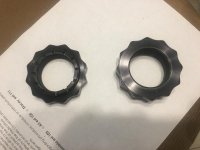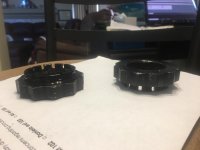-
There were many reasons for the change of the site software, the biggest was security. The age of the old software also meant no server updates for certain programs. There are many benefits to the new software, one of the biggest is the mobile functionality. Ill fix up some stuff in the coming days, we'll also try to get some of the old addons back or the data imported back into the site like the garage. To create a thread or to reply with a post is basically the same as it was in the prior software. The default style of the site is light colored, but i temporarily added a darker colored style, to change you can find a link at the bottom of the site.
You are using an out of date browser. It may not display this or other websites correctly.
You should upgrade or use an alternative browser.
You should upgrade or use an alternative browser.
Another wheel fell off...
- Thread starter stevencovert
- Start date
canamryder
New member
I'm going to wait on blaming the failures on Aluminum. IF the newest batch of nuts crack then "Houston we have a REAL BIG problem". As it was explained, it was the manufacturing process. Going from solid bar stock to hollowed bar was a cost savings big bad idea ("price per lb"). IF the ones crack on my Rally which was manufactured 10/18, then I'll start whimpering. By the way there is actually only one thread on the nuts. Threading is about 14mm length and crown to crown (pitch) is about 1.5mm. The nuts spin on around 9 revolutions to tighten up.
Highwayman2013
New member
Markubis
Member
Now we are all getting on the right page!! Why Alum??? Some places you can loose weight some places you should just leave alone!!! This old welder thinks this is one of those times!!!!!!!
I expect to see some aftermarket steel or titanium at some point.
Anyone know if the threaded axle itself is stainless? That would rule out using stainless nuts.
BLUEKNIGHT911
Sadly Passed Oct 2024 - RIP
Thank you, thank you :yes: …… Could you measure what the 9 Threads are ( ie.3/8 or 1/2 or 5/8 across the width of the threads or whatever ) ……. Mike
canamryder
New member
WHY? are we talking threading now. The threading had Nothing to do with the cracking!
stevencovert
Member
That's what I am thinking. Machined from a solid would give far higher hardness and even strength throughout the material. Extrusions can produce weak spots. Even so these nuts must be under some huge pressure to crack a weak spot!? The pressure on the hub cannot be that awful much given the whole bike's weight. It must get stressed in hard turns maybe? Also I learned that in this instance, when it wobbled a bit he said he hit the brakes hard and it went away. Must have seated everything OK (for a little while) doing that. My guess is hitting the brakes to make it go away was pounding on the nut making a weak spot give. He said it certainly felt like the rotor or brakes on the right side were "catching", never even thought it could be the nut problem - as he took it in TWICE to get looked at. Never again at that place I hope!The fix says the new nuts are solid and not extruded.
Freddy
Active member
................. They're going to cheapo themselves out of business!
No they won't or it would be going down the gurgler already. These Spyder quality issues have been going on for a decade and more, just getting slowly worse. Most folks will keep buying em until they eventually find one that's somewhat reliable; fewer folks dump them. You see some folks here that are on their 5th one. BRP have cornered a niche market and laugh at us because they know quality isn't what sells the trikes for them - it's the buyer's 'I want one' mentality.
BLUEKNIGHT911
Sadly Passed Oct 2024 - RIP
WHY? are we talking threading now. The threading had Nothing to do with the cracking!
:I have removed my ( totally un-offensive ) post ….. due to ….. well let's just say I removed it and leave it at that ………….. ride safe - ride happy ….. Mike
canamryder
New member
Please read the 3rd paragragh in the "chronology" section in................................ https://static.nhtsa.gov/odi/rcl/2019/RCLRPT-19V683-8289.PDF
Highwayman2013
New member
7/16"
BLUEKNIGHT911
Sadly Passed Oct 2024 - RIP
7/16"
Thanks, 9 threads @ 7/16 wide …… that should be sufficient ….. It must be the metallurgy …… And I'll repeat - why isn't it made of steel ????? …………………. You would think after the " windshield arm fiasco " they would have learned something …… guess not :gaah::gaah: ………………… Mike
PMK
Active member
12 point wrenching design, with 12 slots for the safety pin, each safety pin slot, aligned with the lowest portion of the wrenching area “V” notch. Both machined and cutting more notches along the materials grain.
So, in theory, you have an aluminum nut, unless forged it will have a grain structure aligned with the bore of the threads, and failures occurring from the “V” notch into the safety pin slot, so essentially failures are on the smallest cross sectional area.
The actual design is cosmetically pretty, but the structural design is lacking. Add to this, threads create an expending force into the nut when tightened.
Certain aluminums have a failure characteristic known as “notch sensitivity”. So high strength aluminum, likely prone to notch sensitivity concerns, utilized in a poorly designed mechanical fastener, under expanding tensile stress, failed at the weakest cross sectional area of the fastener, seems about correct to me.
Unless the new nuts are forged, altering the grain alignments, and the design repositioned the safety pin slots, the use of solid bar extrusion, vs hollow bar extrusion may not matter. Those suggesting inclusions within the material as the cause may be correct. However if that is the case, the material used is inferior.
canamryder
New member
As far as the info I have read the only nuts that cracked were made approx. between 2/19 and 9/19. Those were made from hollow bar stock per the NHTSA.
The ones made before that date were made from solid bar stock (mine? 10/18). If the pre 2/19 and/or the new nuts start cracking then I'll agree and blame the use of aluminum. Now I'm blaming the process of going to hollow stock not the stock material itself.
All they did to fix the problem was to go back to form (extrude) solid bar stock. Probably with stock milled out on one of the roughly shaped 12 recessed areas in the dies to add extra stock for machining in the new nut ID area. The old dies could be used this way.
Somewhere in the Ryker blog I read that the reason for the cracks, per the NHTSA, was "cold shots" formed in the hollow extrusions. I wish I could find it. No where are threads mentioned as the problem.
Until the pre 2/19 and the new design nuts start cracking I'll consider the issue fixed. Getting the new nuts out in the field for owners waiting for the new nuts and properly trained techs. is another story. Now I wonder what the next issue will be from Can Am:gaah:
The ones made before that date were made from solid bar stock (mine? 10/18). If the pre 2/19 and/or the new nuts start cracking then I'll agree and blame the use of aluminum. Now I'm blaming the process of going to hollow stock not the stock material itself.
All they did to fix the problem was to go back to form (extrude) solid bar stock. Probably with stock milled out on one of the roughly shaped 12 recessed areas in the dies to add extra stock for machining in the new nut ID area. The old dies could be used this way.
Somewhere in the Ryker blog I read that the reason for the cracks, per the NHTSA, was "cold shots" formed in the hollow extrusions. I wish I could find it. No where are threads mentioned as the problem.
Until the pre 2/19 and the new design nuts start cracking I'll consider the issue fixed. Getting the new nuts out in the field for owners waiting for the new nuts and properly trained techs. is another story. Now I wonder what the next issue will be from Can Am:gaah:
Attachments
. Wow! Now that’s an answer that should be forwarded to BRP. IMO.12 point wrenching design, with 12 slots for the safety pin, each safety pin slot, aligned with the lowest portion of the wrenching area “V” notch. Both machined and cutting more notches along the materials grain.
So, in theory, you have an aluminum nut, unless forged it will have a grain structure aligned with the bore of the threads, and failures occurring from the “V” notch into the safety pin slot, so essentially failures are on the smallest cross sectional area.
The actual design is cosmetically pretty, but the structural design is lacking. Add to this, threads create an expending force into the nut when tightened.
Certain aluminums have a failure characteristic known as “notch sensitivity”. So high strength aluminum, likely prone to notch sensitivity concerns, utilized in a poorly designed mechanical fastener, under expanding tensile stress, failed at the weakest cross sectional area of the fastener, seems about correct to me.
Unless the new nuts are forged, altering the grain alignments, and the design repositioned the safety pin slots, the use of solid bar extrusion, vs hollow bar extrusion may not matter. Those suggesting inclusions within the material as the cause may be correct. However if that is the case, the material used is inferior.
Rob Rodriguez
New member
I'm no expert but I work in the engineering field. With the quality of simulation software engineers are able to test all sorts of parts/designs/ideas for various types of failures before the actual part is ever built. The software is expensive and BRP is running the Dassault Systems suite of tools. These are the same tools many aerospace companies use (boeing, Airbus, etc) to simulate designs. The software is very accurate. I'm not saying it never happens but typically, in today's world, if a failure takes place its a materials/manufacturing issue rather than a design issue. You can't completely release the engineer/designer from the hook because its possible they design something difficult to make and that leads to a materials/manufacturing issue but in general an experienced engineer would know if a design will fail long before its ever built.
Similar threads
- Replies
- 2
- Views
- 553
- Replies
- 35
- Views
- 6K
- Replies
- 15
- Views
- 2K
- Replies
- 4
- Views
- 759


